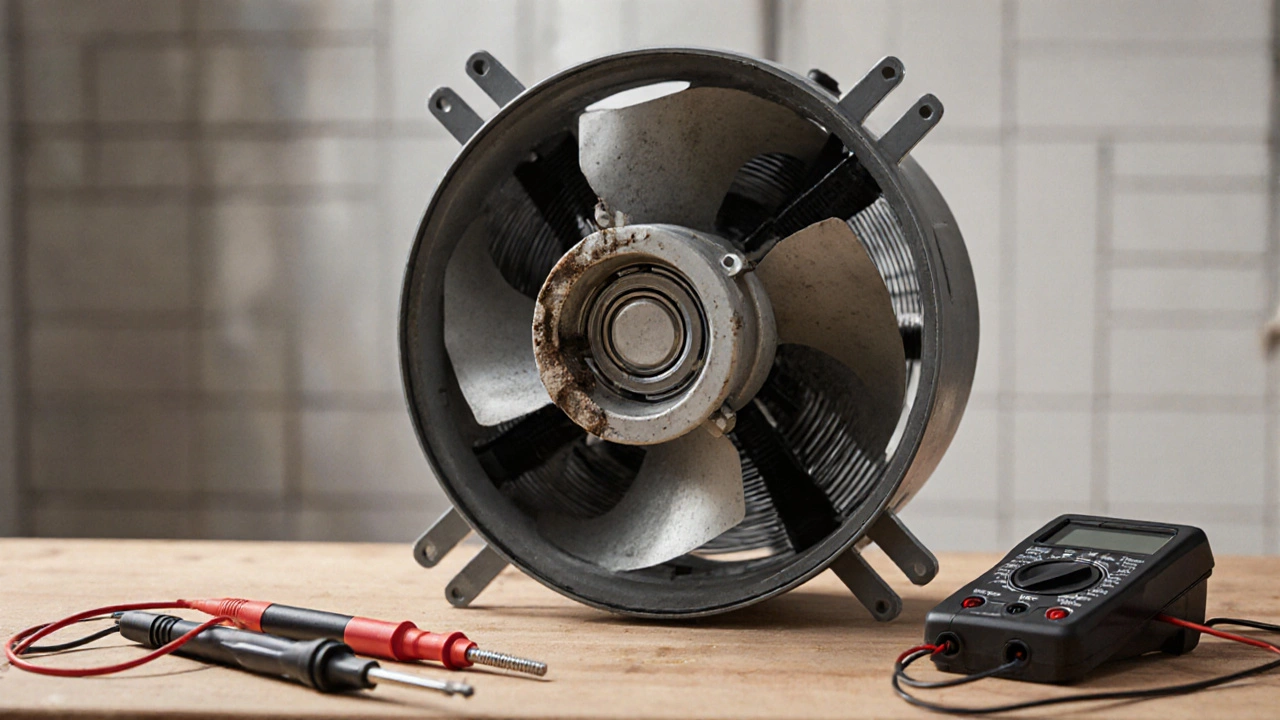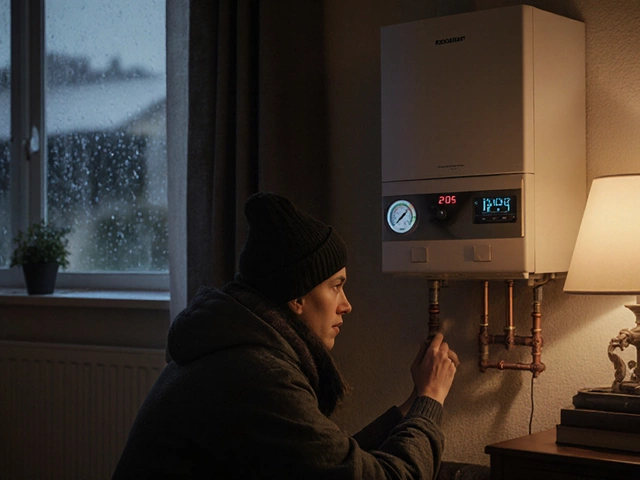Exhaust Fan Repair Cost Calculator
Calculate whether repairing your exhaust fan is more cost-effective than replacement based on your specific situation.
Ever turned on your kitchen or bathroom exhaust fan and heard a grinding noise, or worse - nothing at all? You’re not alone. In Auckland’s humid climate, extractor fans work overtime to pull out steam, smells, and moisture. But when they start acting up, most people just assume it’s time to replace the whole thing. The truth? Exhaust fan repair is often possible - and way cheaper than buying new.
When an exhaust fan can be fixed (and when it can’t)
Most exhaust fans fail for one of three reasons: dust buildup, a worn motor, or a broken capacitor. If your fan’s blades are caked in grease and grime, or it hums but won’t spin, you’re looking at a fixable issue. But if the housing is cracked, the wiring is melted, or the motor casing is rusted through, it’s usually not worth repairing.Here’s a quick rule of thumb: if the fan is under 8 years old and the noise is new, fix it. If it’s older than 10 years and has been making noise for months, replacement is smarter. Most fans last 10-15 years with proper cleaning. But if you’ve ignored maintenance, you’re fighting a losing battle.
Step-by-step: How to diagnose your exhaust fan
Before you call a technician or head to the hardware store, do this simple check. Turn off the power at the circuit breaker. Safety first.- Remove the fan cover. Most snap off or are held by two screws. Don’t force it.
- Inspect the blades. If they’re sticky with grease, that’s your first clue. Clean them with warm water and dish soap. Dry completely.
- Spin the blades by hand. If they turn freely, the motor might still be good. If they’re stiff or grind, the bearings are seized.
- Look at the capacitor. It’s a small silver or black cylinder near the motor. If it’s bulging, leaking, or smells burnt, it’s dead.
- Check the wiring. Look for frayed wires, loose connections, or burn marks. If you see any, don’t touch it - call a licensed electrician.
If the blades spin smoothly and the capacitor looks fine, the motor might just need cleaning. If it’s seized or the capacitor is blown, those parts can be replaced.
Common exhaust fan parts that can be replaced
You don’t need to replace the whole unit for most failures. Here’s what you can swap out yourself - if you’re comfortable with basic tools.- Capacitor: This small part helps the motor start. It costs under $10 and takes 10 minutes to replace. Match the microfarad (µF) rating and voltage on the old one.
- Motor: If the fan hums but doesn’t spin, the motor is likely dead. Replacement motors cost $40-$80. Make sure the shaft size, mounting holes, and voltage match your old one.
- Blades: Cracked or warped blades cause imbalance and noise. You can buy replacement blades for most models - even older ones - from appliance parts sites.
- Grille or cover: If it’s cracked or discolored, you can replace just the outer part. No need to replace the whole fan assembly.
Brands like Broan, Vent-A-Hood, and extractors from local New Zealand suppliers like Bunnings or Mitre 10 often have compatible parts. Keep the model number handy - it’s usually on a sticker inside the housing.

Why cleaning matters more than you think
In Auckland’s damp homes, exhaust fans get coated in grease and mold faster than you’d expect. A dirty fan doesn’t just run louder - it runs hotter. That extra heat kills motors faster.Every six months, turn off the power and wipe down the blades and housing with a degreaser. Use an old toothbrush for the crevices. Don’t use bleach - it corrodes plastic and metal over time. A mix of white vinegar and water works fine for light buildup.
Also, check the duct. If your fan vents outside (not just into the attic), make sure the duct isn’t crushed or blocked. A clogged duct forces the fan to work harder, shortening its life. If you can’t see through the duct from the outside, it’s time to clean it.
When to call a professional
There are three times you should stop DIY and call someone:- You smell burning plastic or see smoke.
- The fan trips the circuit breaker every time you turn it on.
- You’re not sure about wiring or electrical connections.
Electrical faults in exhaust fans can cause fires. If you’re not confident, it’s not worth the risk. A licensed electrician can diagnose the issue in under 30 minutes and usually replace a capacitor or motor on the spot. Expect to pay $80-$150 for labor - still less than a new fan installation.

Cost comparison: Repair vs. replace
| Option | Parts Cost | Labor Cost | Total Cost | Time to Complete |
|---|---|---|---|---|
| Capacitor replacement | $8-$15 | $50-$80 | $58-$95 | 20-40 minutes |
| Motor replacement | $40-$80 | $80-$120 | $120-$200 | 1-1.5 hours |
| Full fan replacement (DIY) | $100-$250 | $0 | $100-$250 | 1-2 hours |
| Full fan replacement (pro) | $100-$250 | $100-$180 | $200-$430 | 2-3 hours |
As you can see, repairing a fan with a bad capacitor or motor often saves you half the cost of a full replacement - especially if you do the labor yourself. Even if you hire someone, fixing the motor is usually cheaper than installing a new unit.
What to look for in a replacement fan
If repair isn’t an option, don’t just grab the cheapest fan at Bunnings. Look for these features:- CFM rating: Match or exceed your old fan’s airflow. For bathrooms, aim for 1 CFM per square foot. For kitchens, 100-150 CFM is standard.
- Noise level: Look for fans rated under 1.0 sone. Anything above 1.5 sone will be annoying.
- Energy Star certified: These use 20-30% less power and last longer.
- Easy-to-clean design: Removable blades and grease filters make maintenance easier.
Brands like Panasonic, Vent-A-Hood, and Fantech are reliable. Avoid no-name brands from overseas - they often use cheap motors that fail within a year.
Prevent future failures
The best repair is the one you never need. Here’s how to keep your exhaust fan running for years:- Run the fan for 15-20 minutes after showering or cooking.
- Clean the blades and housing every 6 months.
- Check the duct for blockages once a year.
- Replace the capacitor proactively if your fan is 7+ years old - they degrade over time even if the fan still works.
- Don’t cover the fan with a towel or cloth to reduce noise - that causes overheating.
Simple habits like these can double the life of your exhaust fan. In Auckland’s moist homes, that’s not just convenience - it’s preventing mold, rot, and costly repairs down the line.
Can I repair my exhaust fan myself?
Yes, if the issue is a dirty fan, a blown capacitor, or a worn motor. Most repairs involve basic tools and take under an hour. But if you’re dealing with wiring, electrical faults, or a rusted housing, it’s safer to call a professional.
Is it cheaper to repair or replace an exhaust fan?
Repairing is almost always cheaper - unless the fan is over 10 years old. Replacing a capacitor or motor costs $60-$200 total, while a new fan installation can run $200-$430. If the fan is in good condition otherwise, repair saves you money.
Why does my exhaust fan make a grinding noise?
A grinding noise usually means the motor bearings are worn out or the fan blades are hitting something due to grease buildup. Clean the blades first. If the noise remains, the motor likely needs replacing. Don’t ignore it - grinding speeds up motor failure.
How long should an exhaust fan last?
With regular cleaning, most exhaust fans last 10 to 15 years. Without maintenance, they can fail in as little as 5 years. Dust and moisture are the biggest killers. Clean it every six months and check the duct annually.
Can a bad exhaust fan cause mold?
Absolutely. If your fan isn’t removing moisture, it builds up on walls, ceilings, and in corners. That’s prime territory for black mold, especially in bathrooms and kitchens. A working exhaust fan is one of the best defenses against mold in New Zealand homes.


